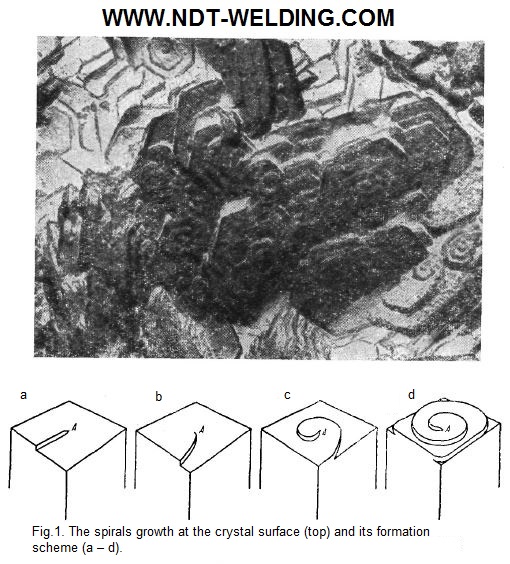The outcrop of the crystal screw dislocation, Fig.1.

It creates conditions for the steps formation with the height equal to vector shift dislocation. Especially, they are important for the close-packed faces; in this case, the growth becomes possible even at low degrees of supercooling. The atoms joining to the step leads to spiral growth as each its area has in the initial state a straight view and its moves with an identical linear speed around the dead center of dislocation. The areas near the dislocation will have a high angular speed and will make more turns than far remove. Finally, the spiral is formed (Fig. 1 d). The existence of such crystal faces germproof growth mechanism by the continuous reproduction of steps is confirmed by the existence of the spirals identified for many metals and nonmetals (Fig. 1 above). The spiral and steps at the growing crystal surface can be observed, if you remove the liquid remains (the decantation method). At the same time it is possible to observe the not unit steps (Fig.2 a),

and its clusters are the large steps (Fig. 2 b). Each step has the height close to interatomic distance. The movement speed of the small steps at the crystal surface in consequence of the side growth caused by the atoms joining is various also B, C and D steps can overtake the A step. Finally, the large step is formed including A, B, C, D steps.
There are several reasons for such steps consolidation. The occurrence before the moving step of the new layer. For example, because of the two-dimensional germ formation will lead to the fact that the AB area of the face (Fig. 2 b) will be built up before the A step will manage to be removed considerably from the B area. The retraction speed of the prominent crystallizing heat has influence on the steps speed movement. Its allocation leads to the fact that the steps located close to one to another and grow more slowly, than far remove. The far remove will overtake the slowly moving and will slow down the own movement. Thus, the monoatomic steps thickness are combined into groups.






